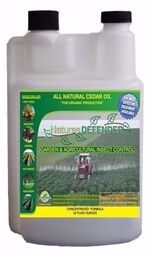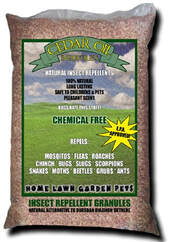10 Organic Ways to Kill Fleas, Ticks and Garden Pests
|
Many organic oils will kill garden pests and repel mosquitoes, but don't forget to consider the evaporation rate of various oils. In aromatherapy, a "top note" is defined as the first note you'll smell in a perfume blend. It comes out fighting but fades quickly. A "base note" is the lingering essence you smell when the top note is long gone. Try blending your own essential oil formulas to achieve the perfect punch with long lasting residual effects!
|
1. Orange Oil: Smells great and delivers a nice punch
|
Orange oil is commonly used as a cleaner, furniture polish and disinfectant. In addition to killing germs, orange oil can also be used as an insecticide! In fact, orange oil is the most common organic treatment used by termite companies. As a top note, it fades more quickly than base note oils, but you can always make your own blend featuring orange with clove, cedar or sandalwood. For a basic pest controlling mix, add two ounces of orange oil to one gallon of water.
32 Ounces for $25.99.
|
2. Neem Oil - Smells terrible but works like a charm
|
Neem oil is one of the most popular pesticides used in organic farming. When you consider the price, it's no wonder that serious farmers with lots of square footage rely upon neem oil to battle a wide variety of pests. Mix 1 1/2 teaspoons of neem oil per quart of water (1 oz/gallon) plus 1/2 tsp of dish soap per quart of water.
|
3. Cedar Oil - Strong woodsy scent with great residual effects
|
As a base note, cedar is a popular choice for those who value as lower evaporation rate and strong residual effects. According to the long trusted Farmer's Almanac, Cedar oil doesn't just repel ticks and other irritating insects; it kills them. Using a hose end sprayer, it takes just 6 oz. of cedar oil concentrate to treat up to 5000 sq. ft. of outdoor space. For tank sprayers, mix 2 oz. of product per gallon.
|
4. Cedar Granules - Two months of residual effects - great for egg control
|
All liquid pesticides evaporate, but cedar granules deliver a fresh blast of cedar infused liquid to the soil or grass each time it rains. A generous 20-pound bag sells for around $38. Granules are great for the person who desires a pest free garden but doesn't have time to keep repeating weekly or monthly spray protocols connected to various liquid products. Granules may also be used in conjunction with liquids. Just spray your favorite liquid for an immediate punch and spread granules to keep those effects rolling for months on end.
|
5. Lemongrass Oil - Pleasant to humans. Noxious to mosquitoes!
6. Eucalyptus Oil - So strong it takes your breath away!
7. Diatomaceous Earth - Effective and odor free
|
Diatomaceous earth (DE) is a powdered pesticide made of the tiny, fossilized plankton that accumulate over millennia in fresh water lakes. This moisture leeching dust causes insects to dry out by absorbing oils and fats from the exoskeleton. The sharp edges of the particles are highly abrasive, slashing at the cuticle and speeding up the process.
Advantages:
|
8. Sulfur - Smells like rotten eggs but works like a charm
|
9. Boric Acid - A popular additive for mixing bait
|
Most folks associate boric acid with the treatment of cockroaches and the mixing of bait used to attract roaches and ants, but it's also great for dusting. Beware that pets should not ingest this product. Neither humans nor pets should get it into their eyes. Note that boric acid and Borax laundry detergent aren't the same product. Borax is the basic mineral mined from the ground. A refining process turns it into boric acid. Boric acid is more powder like. The reduced bulk and lower molecular weight promotes superior penetration into the target insect's exoskeleton. Borax for laundry is not labeled for use as a pesticide. When considering the compounds themselves, boric acid has a larger concentration of boron. That means boric acid is stronger than borax. Boric acid has 17.48 (https://en.wikipedia.org/wiki/Boric_acid) and Borax has 11.34% (https://en.wikipedia.org/wiki/Borax).
|
10. Bait Granules - A ready-to-use product for speed and simplicity
|
When you don't have time to mix your own bait using ingredients like sugar, flour and boric acid, you can buy granular bait to spread throughout the garden. Granular bait works exceptionally well against ants, cockroaches, crickets, beetles earwigs, silverfish and carpenter ants! Blood feeding organisms like fleas and ticks won't be as attracted to bait as insects that constantly forage for food. For flea and tick killing agendas, stick to essential oils and follow with cedar granules.
|
Bait recipe for roaches, ants, crickets, beetles, earwigs and more!
Poison Cookie Dough Recipe: For a tasty but poisonous treat that ants will be happy to share with colony members in hidden locations, combine 1/4 tablespoon of boric acid powder with 1 tablespoon of white flour and 1 tablespoon of sugar. Add just enough water to form the mixture into a ball that resembles cookie dough. With gloved hands, pinch away several sections of dough to create several pea-sized drops. Toss dough balls around the perimeter of your home or spread them around the garden. For indoor pest control agendas, stick the drops under counter ledges, above cabinets and under sinks. Do not put bait inside drawers where kitchen utensils are stored. This will encourage ants and roaches to crawl over your silverware in their search for food. The beauty of cookie dough bait is that it can be pressed into place and applied to strategic locations without creating a sticky mess. Note that children and pets shouldn’t come in contact with bait made of boric acid. If you have pets or small children, place bait on top of kitchen cabinets.
Mint Jelly Recipe: Sugar ants are powerfully attracted to mint jelly. Mix 2 tablespoons of jelly with 1/4 teaspoon of boric acid. Place the mixture inside bottle caps or mason jar lids to avoid getting it all over the place. To target protein loving grease ants, mix 1 tablespoon of peanut butter with 1 tablespoon of honey and 1/4 teaspoon of boric acid. Note that children and pets shouldn’t come in contact with bait made of boric acid. If you have pets or small children, place bait on top of kitchen cabinets.
Mint Jelly Recipe: Sugar ants are powerfully attracted to mint jelly. Mix 2 tablespoons of jelly with 1/4 teaspoon of boric acid. Place the mixture inside bottle caps or mason jar lids to avoid getting it all over the place. To target protein loving grease ants, mix 1 tablespoon of peanut butter with 1 tablespoon of honey and 1/4 teaspoon of boric acid. Note that children and pets shouldn’t come in contact with bait made of boric acid. If you have pets or small children, place bait on top of kitchen cabinets.











